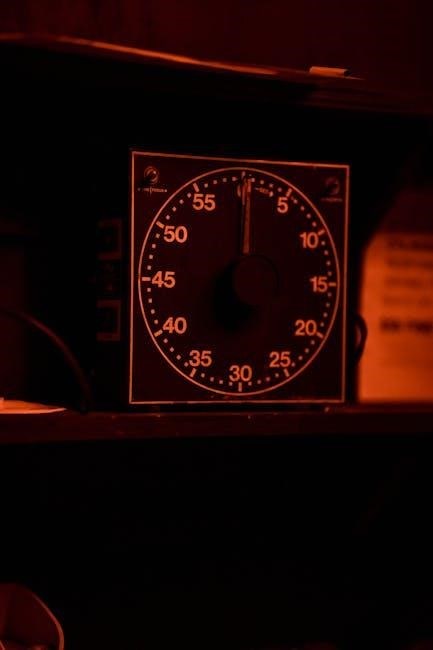Intermatic Manual Timer: A Comprehensive Guide
Intermatic manual timers offer convenient control over electrical devices. These timers‚ both mechanical and digital‚ automate tasks with ease. They manage lighting‚ pumps‚ and appliances effortlessly.
Understanding Intermatic Timers
Intermatic timers are essential for automating electrical devices‚ offering convenience and energy savings. These timers come in various types‚ including mechanical and digital models‚ each designed for specific applications.
Mechanical timers are known for their simplicity and ease of use‚ often featuring a rotating dial with pins to set on and off times. They are ideal for basic timing needs‚ such as controlling lights or pumps on a fixed schedule.
Digital timers provide more advanced features‚ including multiple on/off settings‚ programmable schedules‚ and manual override options. They offer greater flexibility and precision‚ making them suitable for complex timing requirements. Understanding the functionality and setup of Intermatic timers is crucial for maximizing their benefits. Whether you need a simple mechanical timer or a sophisticated digital model‚ Intermatic provides reliable solutions for automating your electrical devices. These timers are designed to directly switch loads up to 30 amps and to switch resistive or inductive loads up to the time switch rating.
Types of Intermatic Timers
Intermatic timers come in two main types: mechanical and digital. Mechanical timers use a rotating dial‚ while digital timers offer programmable settings. Both automate electrical devices effectively.
Mechanical Timers
Mechanical timers from Intermatic are known for their simplicity and reliability. These timers typically feature a rotating dial that users set to control the on/off cycles of connected devices. Often‚ they are the TN111K model and do not require a neutral wire.
Intermatic mechanical timers are perfect for applications where precise timing isn’t crucial‚ such as controlling bathroom fans or basic lighting systems. They offer a manual override feature‚ enabling users to temporarily bypass the programmed settings.
These timers are robust and require minimal maintenance‚ making them a cost-effective solution. The Heavy Duty 60-Minute in-Wall Spring Wound Countdown Timer Switch is a great mechanical option.
Mechanical timers are easy to install and operate. The user-friendly design makes them ideal for those who prefer a straightforward approach to automation. They are the most basic timer type.
Digital Timers
Digital timers from Intermatic provide advanced programming capabilities and increased precision compared to their mechanical counterparts. Models like the DT121C and DT17‚ offer multiple on/off settings‚ often up to 14 pairs per day. The minimum setting interval is usually one minute.
Intermatic digital timers include features like automatic or manual operation‚ allowing users to switch plugged-in lights on or off at any time. They often have a random mode to vary settings.
These timers commonly use a battery backup to maintain programmed settings during power outages. Digital timers are suitable for applications requiring precise timing‚ such as controlling pool pumps or landscape lighting.
Digital timers allow for block programming‚ which simplifies setting schedules for different days of the week. Some models also include an astronomical clock feature‚ adjusting on/off times based on sunrise and sunset.

Setting Up Your Intermatic Timer
Setting up your Intermatic timer involves initial steps like battery activation. Then‚ programming the timer to match your desired schedule. Ensure correct time input for automated operation.
Initial Setup and Battery Activation
Commencing the initial setup of your Intermatic timer often involves activating its internal battery. Many digital models ship with batteries needing activation. Locate the battery compartment‚ usually on the timer’s back or side. Remove any protective film preventing contact. For some models‚ pressing a reset button might be necessary after installing the batteries.
Mechanical timers might not require batteries but check for proper installation. Ensure the timer is securely mounted. Double-check all wiring connections for safety. Before programming‚ verify that the timer displays the correct time. Some digital timers require setting the current date. This ensures accurate operation according to your programmed schedule. Consult your timer’s manual for specific battery types needed.
Proper battery activation guarantees reliable timer functionality. It also ensures uninterrupted operation even during power outages. Some timers use a rechargeable battery. Allow sufficient charging time before full operation.
Programming the Timer
Programming an Intermatic timer involves setting specific on/off times. Digital timers use buttons or a touchscreen interface. Mechanical timers utilize pins or dials. To program a digital timer‚ navigate the menu using the designated buttons. Set the current time and date first. Then‚ create on/off events based on your desired schedule. Specify the days of the week for each event.
Mechanical timers are programmed by pushing pins in or out. Each pin represents a specific time interval. Pushing a pin in activates the connected device during that interval. Digital timers often offer multiple programs. This allows for different schedules on different days. Many models have a minimum setting interval of one minute.
For complex schedules‚ consult the timer’s manual. Ensure the timer is in “auto” mode for programmed operation. Test your settings to verify accuracy. Some timers have a random mode. This varies the on/off times slightly for security purposes. Regularly review your program to adjust for changing needs.

Manual Override Functionality
Manual override functionality is a key feature of Intermatic timers. It allows users to temporarily bypass the programmed settings. This provides immediate control over connected devices. The override feature is useful for unexpected situations. For example‚ you might need to turn lights on or off outside the scheduled times.
Digital timers typically have an “override” button. Pressing this button toggles the device on or off. Some models offer a temporary override. This reverts to the programmed schedule after a set time. Mechanical timers may have a switch. This switches between “timed” and “always on/off” modes.
Understanding the manual override is essential for efficient use. It provides flexibility without disrupting the overall schedule. Use the override when needed. Remember to return the timer to its automatic setting. This ensures the programmed schedule resumes. Check the specific instructions in your timer’s manual. This will help to understand the correct operation of the override function.

Troubleshooting Common Issues
Troubleshooting an Intermatic timer involves addressing several common problems. If the timer isn’t working‚ first check the power supply. Ensure the timer receives power. For digital timers‚ verify the battery is functional. Replace the battery if needed.
If the timer is running but not switching‚ examine the wiring. Ensure the wiring is properly connected. Loose connections can prevent the timer from functioning correctly. For mechanical timers‚ confirm the pins are correctly set. For digital timers‚ double-check the program settings. Incorrect settings are a common cause of malfunction.
Another issue is the timer running inaccurately. If the timer is running too fast or slow‚ it may need resetting. For digital timers‚ consult the manual for reset instructions. If problems persist‚ consider replacing the timer. Before replacing‚ review the user manual for specific troubleshooting steps. Consulting the manual often resolves many issues.

Applications of Intermatic Timers
Intermatic timers find extensive use in various applications‚ offering automated control for numerous devices. One primary application is controlling pool pumps. Timers efficiently manage pump operation‚ reducing energy consumption. They also ensure optimal water circulation.
Lighting control is another significant application. Intermatic timers automate indoor and outdoor lighting‚ enhancing security. They also provide convenience by automatically turning lights on or off. These timers are also suitable for automating landscape lighting. This adds aesthetic appeal while saving energy.
Water heaters benefit from timer control‚ reducing energy waste. Timers can schedule water heater operation during peak usage times. They are also employed in hydroponic systems to manage grow lights. This ensures proper light cycles for plant growth. Intermatic timers also automate appliance operation. This includes fans and other household devices. Their versatility makes them ideal for many automation needs.

